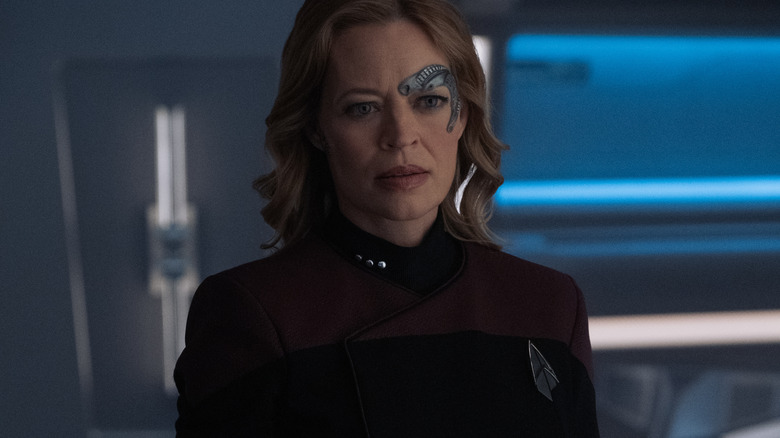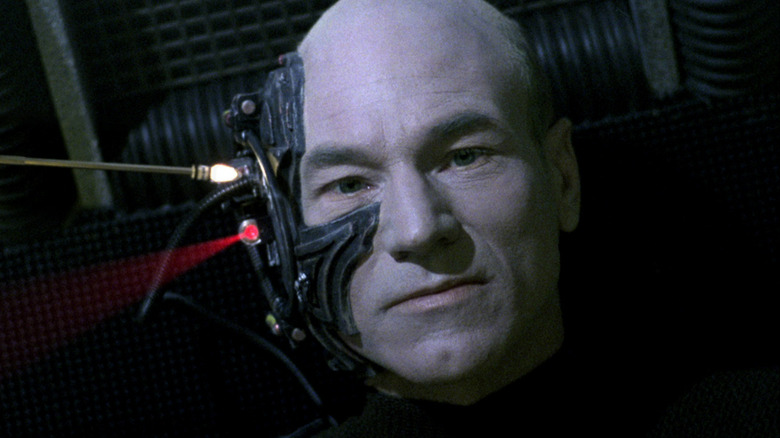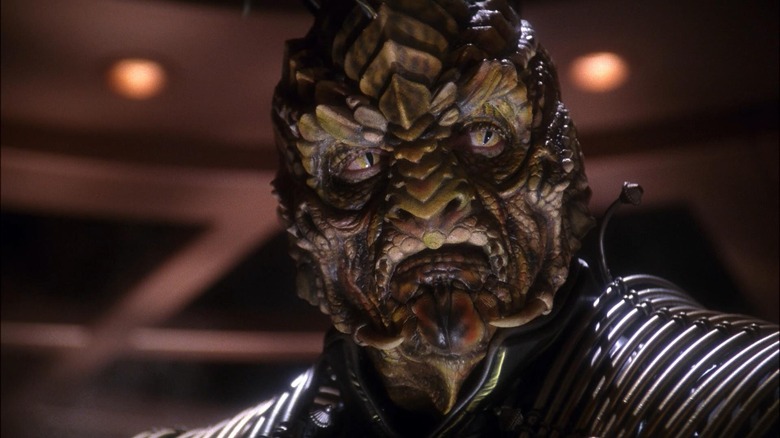Star Trek: Picard Showrunner On How The Borg Are Always There, Even When They're Not [Exclusive]
The Borg, a malevolent species of cyborgs from the deepest reaches of space, first appeared on "Star Trek: The Next Generation" during its second season in an episode called "Q Who" (May 8, 1989). In that episode, the USS Enterprise was thrown across the galaxy by the godlike alien Q (John de Lancie) to face a threat that Q knew it couldn't handle. The Borg — sharing a single, machine consciousness — had no voice, no ability to reason, and no motivation. They simply aimed to carve up the Enterprise and incorporate its crew and technology into its own collective. Diplomacy was not an option, weapons didn't help, and no amount of cleverness helped. The Borg would absorb them. Only Q could help them.
The Borg were such a fascinating species that "Star Trek" brought them back time and time again, even to the point of exhaustion. They were the central antagonists of the third and sixth season finales of "Next Gen." They were featured in a movie. Starting in its fourth season, one of the main characters on "Star Trek: Voyager" was a Borg, and the Borg would factor heavily into that show besides. After a while, the Borg were no longer a threat, but a constant droning presence in "Star Trek," always humming right in the background.
/Film's own Vanessa Armstrong recently spoke with Terry Matalas, the showrunner for the third season of "Star Trek: Picard," and asked if the Borg would come into play in the new show as well. That is, apart from the fact that former Borg Seven of Nine (Jeri Ryan) was still a regular on the series, and that Picard (Patrick Stewart) was once assimilated.
What are the Borg, really?
Matalas was, of course, coy about the potential inclusion of the Borg on "Picard" — he didn't want to give anything away, one way or the other. But he did wisely point out that the Borg have become a symbol in "Star Trek." After Jonathan Frakes' 1996 feature film "Star Trek: First Contact," it was revealed that Capt. Picard was deeply wounded by his experience of being assimilated and had come to resent the constant, unstoppable power the Borg possessed. In that film, Picard was deeply out of character, transforming himself into a tank-top-wearing, revenge-obsessed fighter, happy to kill any Borg that stood in his path. "I will make them pay for what they've done," he yells, a very un-Picard sentiment.
After that film, and deep into "Voyager," more and more characters were introduced that were rescued and rehabilitated from the Borg's assimilation process. Each one of them was traumatized by the experience and had to claw their original identities back from the machinations of insidious cyborg implants throughout their brains and bodies. The Borg came to represent an ever-present traumatic force in "Star Trek," often being the experience that marked certain characters forever. Matalas sees that symbolism, and notes that it does play into "Picard," saying:
"I think it's all about trauma. I think there's certainly, those things are part of 'Star Trek' DNA, specifically in this timeline. I think you're also looking at a post-Dominion War era, and so that stuff feeds in. Those major events should continue to be part of the conversation. We still talk about 9/11 on a daily basis and play a part. So it feels like it would be part of that conversation."
Trek and trauma
Of course, the Borg weren't always about trauma. That was something the other franchise shows eventually adopted over time. It's notable that Matalas should mention 9/11, as that event altered a lot of popular entertainment, quite immediately. On a surface level, action pictures that featured the wholesale destruction of cities and buildings were, for some time, considered in poor taste. Remember in 1996, when Roland Emmerich could explode the White House as a thrilling, climactic moment in "Independence Day"? After 9/11, the United States began a cultural epoch that involved alternating states of mourning and wartime revenge. Suddenly the diplomacy and pacifism of Gene Roddenberry's 1960s utopian sci-fi series seemed naïve and out of place.
"Star Trek" attempted to reconcile the nation's post-9/11 ethos by incorporating a very 9/11-style story into "Star Trek: Enterprise," the series that was airing at the time. A mysterious species called the Xindi, unknown to Earth, appeared out of nowhere and destroyed the entire state of Florida. The entire season was devoted to tracking them down and enacting revenge. The show became more intense and unified but wasn't very "Trek"-like. It's certainly also notable that J.J. Abrams' 2009 "Star Trek" feature film, and its sequels, were about violence, revenge, and action. This was what "Star Trek" had to become after 9/11.
In 2023, we're essentially looking at the next generation of trauma. Grudges still exist regarding the Borg, and healing still needs to take place, even if the Borg aren't physically present to fulfill their usual plot functions or do their symbolic due diligence.
Borg or not, there will always be something hovering over the shoulder of "Star Trek." One might hope, though, that the world is ready for utopia again.


